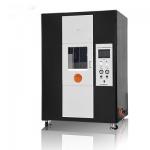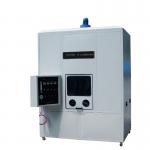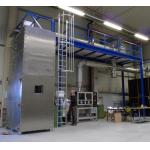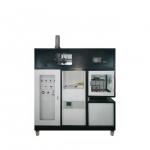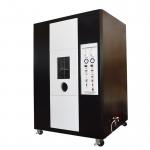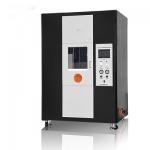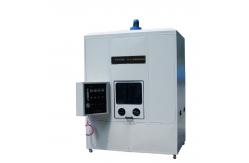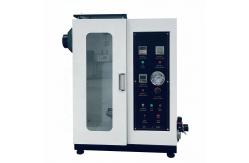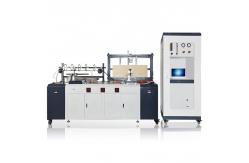In the dynamic landscape of fire safety and materials engineering,
customized flame resistance testing equipment has emerged as a
linchpin for ensuring the reliability and safety of a myriad of
products and structures. This state-of-the-art equipment is
meticulously crafted to meet the exacting and diverse demands of
industries spanning from construction and manufacturing to
aerospace and automotive, where the ability of materials and
components to withstand and resist the ravages of fire is not just
a desideratum but an absolute imperative. The Customized Flame Resistance Testing Equipment represents a
suite of highly sophisticated and purpose-built instruments that
are dedicated to the comprehensive evaluation of the flame
resistance characteristics of an extensive range of materials,
products, and assemblies. It serves as an invaluable asset for a
diverse clientele, including research institutions, product
manufacturers, quality control laboratories, and regulatory bodies.
The overarching objective of this equipment is to accurately and
precisely measure and analyze critical parameters such as ignition
time, flame spread rate, heat release rate, smoke production, and
the integrity and durability of materials and structures when
exposed to flames and high temperatures. By providing in-depth and
reliable data, it empowers stakeholders to make judicious decisions
regarding material selection, product design optimization, quality
assurance, and compliance with stringent fire safety regulations
and standards. - Sturdy and Heat-Resistant Structural Design
- The equipment is engineered with a robust framework constructed
from high-grade heat-resistant alloys and steels, ensuring its
ability to endure the extreme thermal and mechanical stresses
encountered during flame resistance testing. The interior chambers
and test compartments are lined with advanced refractory materials,
capable of withstanding temperatures in excess of 1500°C, thereby
maintaining a stable and controlled testing environment. The access
doors and panels are fabricated with double-layered, insulated
structures and equipped with high-performance sealing mechanisms to
prevent heat leakage and the ingress or egress of smoke and gases,
safeguarding the integrity of the test and ensuring the safety of
operators. A specialized viewing window, crafted from
heat-strengthened glass or transparent ceramic materials, allows
for real-time visual monitoring of the test proceedings without
compromising the integrity of the test enclosure.
- Precision Temperature and Flame Control Systems
- Temperature Regulation: The equipment is furnished with a
cutting-edge temperature control system that enables precise and
accurate regulation of the temperature within the testing area. It
can achieve a wide temperature spectrum, ranging from ambient
temperature to 1200°C, with an exceptional degree of accuracy,
typically within ±2°C. This is accomplished through the utilization
of a combination of advanced heating elements, such as silicon
carbide or molybdenum disilicide heaters, and a sophisticated PID
(Proportional-Integral-Derivative) control algorithm. Multiple
strategically positioned thermocouples ensure uniform temperature
distribution and rapid response to any temperature deviations,
while the intuitive control interface permits the programming of
complex temperature profiles, including linear ramps, step changes,
and cyclic temperature patterns, to faithfully mimic a diverse
array of real-world fire scenarios and environmental conditions.
- Flame Manipulation and Control: The flame generation and control
mechanisms are highly versatile and customizable. They are capable
of producing flames with a broad range of intensities, from a
gentle, low-intensity pilot flame to a powerful, high-temperature
turbulent flame. The fuel supply system, which can accommodate a
variety of combustible gases such as propane, methane, or butane,
is equipped with high-precision flow regulators that enable precise
metering of the fuel. The air-fuel ratio can be adjusted within an
extensive range, typically from 1:1 to 20:1, allowing for the
creation of flames with different oxidizing or reducing
characteristics. This flexibility is essential for conducting
comprehensive tests to assess the response of materials to various
types of flame exposures, including the slow-burning, smoldering
flames characteristic of certain fire scenarios and the intense,
rapid flames associated with flashover events.
- Advanced Instrumentation and Data Acquisition Capabilities
- The Customized Flame Resistance Testing Equipment is outfitted with
a comprehensive suite of sensors and measurement devices. In
addition to highly accurate temperature and flame sensors, it
incorporates optical sensors for precise monitoring of flame
characteristics such as height, luminosity, color temperature, and
shape. Smoke density sensors, based on advanced light scattering or
absorption principles, are capable of accurately measuring the
concentration and density of smoke generated during the test. Gas
sensors, designed to detect and analyze the composition of gases
emitted during combustion, including toxic gases such as carbon
monoxide, carbon dioxide, and volatile organic compounds, provide
crucial information about the chemical byproducts of the fire.
These sensors are interfaced with a high-speed, multi-channel data
acquisition system that records and stores all relevant data. The
data acquisition system offers an impressive sampling rate, often
exceeding 10,000 samples per second, ensuring that even the most
transient and minute changes in parameters are faithfully captured.
The collected data can be analyzed in real-time or retrieved later
for in-depth studies using specialized software, which generates
detailed reports and graphical representations of the test results,
facilitating comprehensive data interpretation and analysis.
- Versatile Testing Modes and Configurations
- The equipment offers a wide variety of testing modes and
configurations to accommodate the diverse needs of different sample
types and testing requirements. It can perform horizontal and
vertical flame spread tests, where the behavior of a material's
surface as the flame propagates across it is meticulously observed
and quantified. Cone calorimeter tests can be carried out to
measure the heat release rate and other combustion parameters of a
sample under a controlled radiant heat flux. Additionally, it can
be configured for fire resistance tests of larger structures and
assemblies, such as evaluating the integrity and fireproofing
capabilities of building components, enclosures, or industrial
equipment. The equipment can also be integrated with other
environmental control systems, such as humidity and pressure
control, to study the combined effects of multiple factors on flame
resistance. This versatility makes it suitable for testing a vast
range of materials, from traditional building materials like
concrete, steel, wood, and insulation to advanced industrial
materials such as polymers, composites, and high-tech textiles.
- Compliance with Stringent Industry Standards
- The Customized Flame Resistance Testing Equipment is meticulously
designed to comply with a comprehensive set of international and
national fire safety standards. It adheres to ASTM (American
Society for Testing and Materials) standards, such as ASTM E84 for
surface burning characteristics, ASTM E1354 for heat and visible
smoke release rates, and ASTM E662 for smoke density. It also meets
ISO (International Organization for Standardization) standards,
including ISO 5660 for reaction-to-fire tests and ISO 1716 for
calorific value determination. This strict compliance ensures that
the test results obtained using this equipment are widely
recognized and accepted by regulatory authorities and industry
peers, facilitating seamless product certification and market
access.
- Chamber Size and Capacity Variations
- The equipment is available in a range of chamber sizes to suit
different sample sizes and testing volumes. Smaller chambers may
have interior dimensions of 0.3 meters x 0.3 meters x 0.3 meters,
which are ideal for testing small specimens or individual
components. Medium-sized chambers can measure 0.6 meters x 0.6
meters x 0.6 meters, providing sufficient space for testing larger
samples or a batch of products. Larger chambers, with dimensions
exceeding 1 meter x 1 meter x 1 meter, are suitable for full-scale
testing of building materials or large industrial assemblies. The
interior volume and shape of the chambers are carefully optimized
to ensure proper air circulation and uniform exposure of the sample
to the fire and environmental conditions, thereby enhancing the
accuracy and reproducibility of the test results.
- Temperature Range and Accuracy Specifications
- As mentioned earlier, the temperature can be controlled from
ambient to 1200°C, with an accuracy of ±2°C. The temperature ramp
rate can be adjusted from 0.5°C per minute to 100°C per minute,
allowing for the simulation of both slow and rapid temperature
changes. For example, a slow ramp rate may be used to study the
thermal degradation of a material over an extended period, while a
rapid ramp rate can mimic the sudden increase in temperature during
a fire outbreak or a flashover event.
- Flame Intensity and Control Parameter Details
- The flame intensity can be adjusted over a wide spectrum, with a
maximum heat output equivalent to several megawatts per square
meter. The fuel flow rate can be varied from a few milliliters per
minute to several liters per minute, and the air-fuel ratio can be
precisely controlled within a range of 1:1.5 to 20:1. These
parameters enable the creation of flames with different
characteristics, from a small, stable flame for precision testing
to a large, turbulent flame for more severe fire simulations. The
equipment also allows for the control of flame duration and the
number of ignition sources, providing further flexibility in
testing different fire scenarios.
- Data Acquisition Rate and Resolution Metrics
- The data acquisition system samples sensor data at a rate of 10,000
samples per second. The temperature sensor has a resolution of
0.1°C, the smoke density sensor can detect changes as small as
0.005% opacity, and the gas sensors have a sensitivity in the parts
per million (ppm) range for most common gases. This high-resolution
and high-speed data capture ensure that the equipment provides
detailed and accurate information about the flame resistance
characteristics of the tested samples, enabling in-depth analysis
and interpretation of the test results.
- Compliance with Key Flame Resistance Testing Standards Highlights
- The equipment complies with ASTM E84, ASTM E1354, ASTM E662, ISO
5660, and ISO 1716, among other relevant standards. It can also be
customized to meet specific requirements of other industry
standards or regulatory codes, ensuring its adaptability to
different industries and applications. For example, in the
aerospace industry, it can be configured to meet specific standards
for testing the flame resistance of aircraft cabin materials and
components, while in the automotive industry, it can be tailored to
test the fire safety of vehicle interiors and electrical systems.
- Accurate Simulation of Flame Resistance Scenarios
- The primary function of the equipment is to provide a highly
accurate and realistic simulation of flame resistance conditions.
By precisely controlling temperature, flame characteristics, and
other environmental factors, it allows for the comprehensive
evaluation of how materials and products will perform in an actual
fire. For example, it can determine if a building material will
contribute to the spread of fire, if a product will release toxic
gases that could endanger occupants, or if a component will
maintain its structural integrity under fire exposure. This
information is invaluable for architects, engineers, and product
designers to make informed decisions and develop safer and more
fire-resistant designs.
- Enhanced Product Development and Quality Assurance
- Through detailed flame resistance testing, manufacturers can
identify and address potential fire safety issues in their
products. If a material shows a high flame spread rate or excessive
smoke and toxic gas production, appropriate modifications can be
made, such as adding fire retardants, changing the material
composition, or improving the product's design. This leads to the
development of higher-quality and more reliable products that meet
or exceed fire safety standards. The equipment also serves as a
crucial part of quality control, ensuring that each batch of
products is tested and compliant, thereby reducing the risk of
product recalls and enhancing brand reputation.
- Facilitation of Regulatory Compliance and Certification
- Regulatory bodies rely on accurate and standardized flame
resistance test results to enforce fire safety regulations. The
Customized Flame Resistance Testing Equipment enables manufacturers
to conduct tests in accordance with recognized industry standards,
providing the necessary data for regulatory compliance and product
certification. This helps in streamlining the approval process,
ensuring that products can be legally marketed and used in various
applications, from residential and commercial buildings to
industrial facilities and transportation vehicles.
- Stringent Manufacturing Process
- The flame resistance testing equipment is manufactured under strict
quality control procedures. Each component, from the heating
elements and sensors to the control panel and chamber lining, is
carefully sourced and inspected for quality and performance. The
assembly process is carried out by highly trained technicians in a
clean and controlled environment. The equipment undergoes a series
of calibration and validation tests during the manufacturing
process to ensure that it meets the required accuracy and
performance standards.
- The calibration of temperature, flame, and other sensors is a
critical part of the manufacturing process. It is performed using
traceable reference standards that are calibrated to the highest
levels of accuracy, guaranteeing the reproducibility of the test
results. Rigorous quality audits and inspections are conducted at
various stages of production to maintain the highest level of
product quality and compliance with flame resistance testing
standards.
- Quality Certification and Validation
Our equipment has obtained relevant quality certifications and has
been validated by independent fire testing laboratories. It has
been proven to provide accurate and reliable test results,
conforming to the relevant industry standards. We also continuously
update and improve our product based on the latest technological
advancements and customer feedback from the fire safety industry to
ensure its long-term performance and compliance.
- Construction Industry
- A leading construction materials manufacturer used the Customized
Flame Resistance Testing Equipment to test a new type of wall
panel. The tests revealed that the panel had excellent flame
resistance, with a low flame spread rate and minimal smoke
production. This enabled the company to market the panel as a
high-performance, fire-safe building material, meeting the demands
of architects and building owners for safer construction options.
- A construction firm tested different types of flooring materials in
the equipment. The results showed that one particular flooring
material had a higher heat release rate than expected, which could
pose a fire hazard. By using a different core material and
retesting, they were able to ensure the flame resistance of their
building projects and comply with building codes.
- Manufacturing Sector
- An electronics manufacturer tested the flame resistance of their
circuit boards. The testing identified that certain components on
the circuit boards released toxic gases when exposed to fire. By
redesigning the circuit boards and using fire-retardant components
and coatings, they were able to produce circuit boards that met
flame resistance standards and reduced the potential risk to
consumers in case of a fire.
- A furniture manufacturer used the equipment to evaluate the flame
resistance of their upholstery fabrics. The tests showed that some
fabrics had a rapid flame spread, which could be dangerous in a
domestic or commercial setting. By using fire-retardant-treated
fabrics and testing them again, they were able to improve the flame
resistance of their furniture products and gain a competitive edge
in the market.
- Aerospace and Automotive Industries
- An aerospace company tested the flame resistance of a new composite
material for use in aircraft interiors. The Customized Flame
Resistance Testing Equipment allowed them to simulate the extreme
conditions of a cabin fire, including high temperatures, rapid
temperature changes, and the presence of oxygen. The results helped
them optimize the material's composition and design, ensuring the
safety of passengers and crew in the event of a fire.
- An automotive manufacturer tested the flame behavior of different
wiring harnesses. The testing identified potential weak points in
the harness design, such as areas where the insulation could melt
and cause a short circuit. By redesigning the harness and using
fire-resistant materials, they were able to improve the flame
resistance of their vehicles and reduce the risk of electrical
fires.
- Pre-Sales Technical Consultation
Our team of fire safety experts provides in-depth technical
consultations to help customers understand the capabilities and
suitability of the Customized Flame Resistance Testing Equipment
for their specific testing needs. We offer demonstrations and
training, tailored to the fire safety industry, to familiarize
customers with the operation and functionality of the equipment
before purchase. We also assist in selecting the appropriate test
methods and accessories based on the materials or products to be
tested. - After-Sales Service and Maintenance
We offer comprehensive after-sales service, including on-site
installation and commissioning. Our technicians are available for
regular maintenance, calibration, and emergency repairs. We provide
spare parts and upgrades to keep the test equipment operating at
peak performance. We also offer service contracts that include
preventive maintenance and priority technical support, ensuring the
long-term reliability and availability of the equipment for flame
resistance testing. - Training and Technical Support
We conduct training programs for new users to ensure they can
effectively operate the Customized Flame Resistance Testing
Equipment and interpret the test results. Our technical support
team is available 24/7 to answer questions, provide troubleshooting
assistance, and offer guidance on test method optimization and
compliance with flame resistance testing standards. We also provide
software updates and support for the data acquisition and analysis
systems, enabling customers to take full advantage of the latest
features and technologies in flame resistance testing.
|
